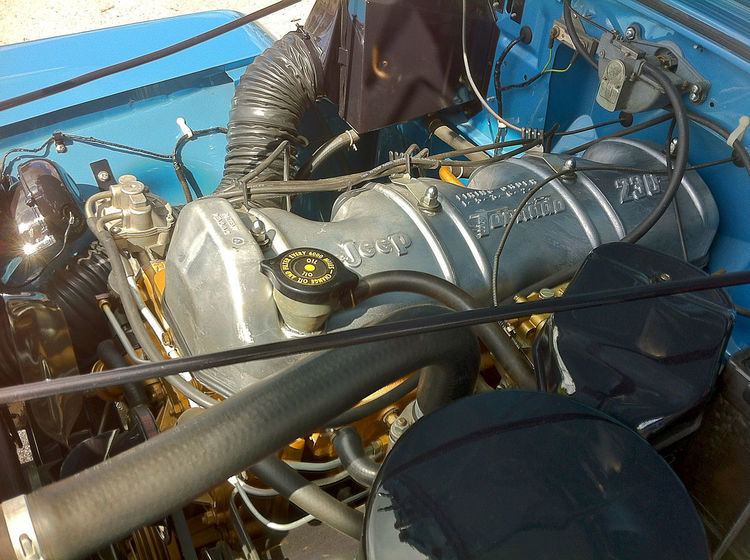Production 1962-1973 Cylinder bore 3.34375 in (84.9 mm) | Displacement 230.5 cu in (3.78 L) Piston stroke 4.375 in (111.1 mm) | |
 | ||
Also called Tornado Jet (IKA)Tornado Interceptor (Renault) | ||
The Jeep Tornado engine was the first post-World War II U.S.-designed mass-produced overhead cam (OHC) automobile engine. The 230.5 cu in (3.78 L) straight-six was introduced in mid-year 1962, and replaced the flathead 6-226 Willys Super Hurricane that was in use since 1954.
Contents
The Tornado engine was also manufactured in Argentina by Industrias Kaiser Argentina (IKA) from 1965 to 1973.
History
The development of a new engine for Kaiser Jeep for an entirely new vehicle began under Chief Engineer, A.C. "Sammy" Sampietro, in the late-1950s. Sampietro worked under Donald Healey in Europe and focused on improving power output through better engine breathing. The single overhead cam design was combined with hemispheric combustion chambers. Mass production of the new engine began in 1962.
The Jeep Tornado engine was introduced in the Willys Jeep Wagon and truck models. Six-cylinder versions built after May 3, 1962, received the 230 OHC "Tornado" engine, replacing the 226 L-head "Super Hurricane" I6. It was made the standard engine in the completely new Jeep Wagoneer station wagons (today called SUV) and Jeep Gladiator pickup trucks that began production in the fall 1962 for the 1963 model year.
The Tornado was the only U.S.-built overhead-cam engine in production at that time. The new engine was designed for robust, heavy-duty performance with maximum efficiency. Its excellent fuel economy was proven in tests with the Tornado-OHC engine having the lowest specific fuel consumption of all production gasoline engines on the market.
Design
The Tornado, like most Jeep engines, was undersquare for better low-speed torque. It had a 311/32 inch (84.93mm) bore with a 43/8 inch (111.1mm) stroke. The standard version had an 8.5:1 compression ratio. Output was 140 hp (100 kW) at 4000 rpm and 210 lb·ft (280 N·m) of torque at 1750 rpm. A low-compression (7.5:1) version was also available, with 133 hp (99 kW) at 4000 rpm and 199 lb·ft (270 N·m) of torque at 2400 rpm. It was a "high-efficiency" engine with a conservatively rated power output.
The new engine's overhead camshaft design was only one of the advanced features offered for the first time in a U.S.-designed and mass-produced engine. The Tornado was a good engine; unfortunately, it was complex (by 1960s standards) and was discontinued in civilian vehicles in the U.S. in 1965. It continued to be used in military versions of the Jeep pickup, the M-715 and M-725, until 1969. These engines had block-mounted motor mounts, rather than the front cover mounts that were a cause of oil leaks on the civilian versions.
One unique feature of the design was that the camshaft only had six lobes. One lobe operated both the intake and exhaust valve for each cylinder. This made engineering cam profiles a bit more difficult than conventional two lobe per cylinder (one per valve) designs, but allowed the valves to be better arranged for the cross-flow head. Valves were directly opposite their respective ports, and ports were short with wide radius turns.
Road tests of the new Jeep Wagoneer by Car Life magazine described the OHC six as "commendably smooth and quiet." The engine accelerated the four-wheel-drive full-size station wagon (the SUV designation was not yet known) with an automatic transmission from 0 to 60 mph in 15.9 seconds. Their tests recorded 17 mpg‑US (14 L/100 km; 20 mpg‑imp) on the highway and 14.5 mpg‑US (16.2 L/100 km; 17.4 mpg‑imp) in the city, that "certainly demonstrates the remarkable efficiency of the OHC engine."
Production
Production of this engine continued in Argentina by Industrias Kaiser Argentina (IKA) after 1965. The engine was used in a variety of Jeep vehicles and American Motors (AMC) passenger cars assembled under license. The engine became best known for powering the IKA-Renault Torino, their version of the AMC Rambler American having unique styled front body parts that was built in Argentina from 1966 to 1981. It achieved international success in the 1969 Nürburgring 84-hour endurance race when a Torino placed third due to penalty points after covering 334 laps, the most of all the racers (c.9450 km/5868 mi.).
The engine name was changed to "Torino" to match the car in 1973. It also received a major block and crankshaft refinement that year — seven main bearings instead of the original four. Industrias Kaiser Argentina was eventually bought out by Renault, and in 1975, the "IKA" name was dropped and it became "Renault Argentina". The Torino, Jeeps, AMC cars, as well as the Tornado engine itself, continued to receive upgrades over the years. Argentinian's Tornado engines raised up the power from 155 HP to 215 HP (street versions) and 250 HP to 350 HP (Racing versions). It was achieved by a new Cylinder head, which has improved the intake and exhaust ducts. Also adopted a new camshaft, a new exhaust manifold 3-1 / 3-1 type, two 2" diamenter exhaust pipes and 3 carburators Weber DCOE 45-45. The Torino and the Jeep Tornado engine continued production through 1973. It was marketed as the "Tornado Jet", and later as the "Tornado Interceptor", in AMC automobiles. From 1976 to 1982 they were the only non-Renault–designed cars and engines built by the French company.
Applications
The Jeep Tornado engine was used in the following vehicles:
